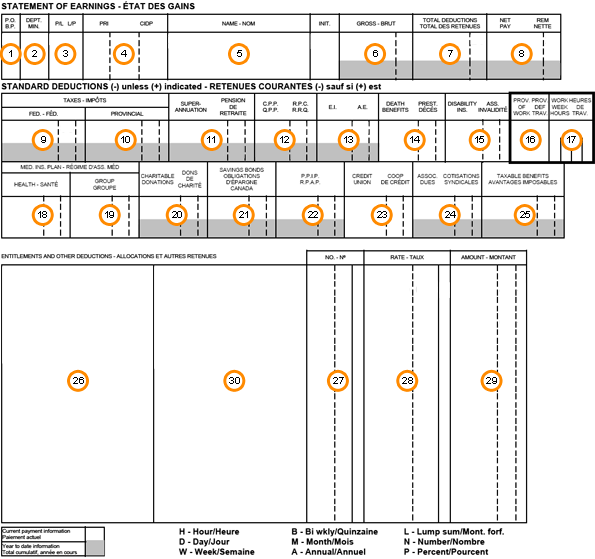ARCHIVED Your Payment Statement (Pay Stub)
 This Web page has been archived on the Web.
This Web page has been archived on the Web.
Archived Content
Information identified as archived is provided for reference, research or recordkeeping purposes. It is not subject to the Government of Canada Web Standards and has not been altered or updated since it was archived. Please contact us to request a format other than those available.
Explanation of Pay Stub
The following is a sample of what your pay stub (whether attached to a cheque or a Direct Deposit Statement) will look like as well as a brief explanation of each field.

This image shows a sample of a pay stub. The first three rows of information are contained within the top third of the overall pay stub. The first row of information concerns your statement of earnings. Starting from left to right, you will find fields 1 through 8. The second and third rows show information pertaining to standard deductions. From left to right, fields 9 through 17 are shown on the second row, while fields 18 through 25 are shown on the third. Fields 26 through 30 are found in the bottom two thirds of the pay stub, from left to right in the following order: 26, 30, 27, 28 and 29. You will find a brief description of each field below.
Statement of Earnings
- Pay office number
- 08 = Halifax,
- 25 = Montreal,
- 34 = Toronto,
- 36 = Ottawa,
- 62 = Edmonton,
- 66 = Vancouver
- Departmental abbreviation
- Paylist number
- Personal Record Identifier (PRI)
- Name and initials
- Gross pay for the two-week period ending on the pay day (this includes salary and allowances)
- Total deductions withheld from this particular cheque
-
Net pay = gross pay less the deductions
Standard deductions
(variable depending on your marital status, tax rate and salary)
- Federal taxes deducted according to tax code, salary and province of employment.
- Provincial taxes deducted according to province of employment.
- Contributions to your pension plan.
- Canada Pension Plan/Quebec Pension Plan
- Employment Insurance
- The Supplementary Death Benefit is a life insurance type coverage. Participation in this plan is mandatory. Coverage is equal to twice your annual salary plus bilingual bonus (if applicable) rounded to the next multiple of $1,000. Premiums are calculated at 15 cents per $1,000 of coverage.
- Disability Insurance (DI): if your position is not represented by a bargaining agent (or excluded) you will be covered under the Long-term Disability (LTD) Plan by National Life of Canada. Otherwise, you will be covered under the DI Plan by Sun Life of Canada.
- Province of work (income tax is deducted based on province of work)
- 10 = Newfoundland and Labrador (NL),
- 11 = Prince Edward Island (PE),
- 12 = Nova Scotia (NS),
- 13 = New Brunswick (NB),
- 24 = Quebec (QC),
- 35 = Ontario (ON),
- 46 = Manitoba (MB),
- 47 = Saskatchewan (SK),
- 48 = Alberta (AB),
- 59 = British Columbia (BC),
- 60 = Yukon (YK),
- 61 = Northwest Territories (NT)
- Assigned work week (the number of hours you work in a week)
- Provincial Health Plan deductions (BC, Alberta)
- Public Service Health Care Plan deductions (PSHCP)
- Charitable donations (e.g. United Appeal)
- Canada Savings Bonds deduction (if applicable)
- Provincial Parental Insurance Plan (PPIP)
- Credit Union Deduction (for loan payments, registered retirement savings plan, savings, etc.)
- Association or union dues deduction (if applicable, deduction is taken from the second pay of the month)
- Taxable Allowance Benefits - employer paid benefits for reporting on your T4
- Entitlements and other deductions
(variable depending on your status and voluntary deductions)
Outlines salary and allowances for the period covered. The deduction adjustment is an accounting mechanism used by the Pay System to regularize the net amount of your cheques. The amount shown as a deduction adjustment on one cheque (plus or minus) will be reversed on the following cheque that same month. The province of Quebec and Ontario charge Sales Tax on insurance premiums. For Quebec, the amount is 9% on all insurance premiums and for Ontario the amount is 8%.
- This is used to describe the number of units or hours being paid for certain entitlements (usually overtime) or deductions.
- The rate used for the entitlement or deduction.
- The actual amount paid or deducted.
- Message
A message will be printed on your payment statement only when there is a need to advise you of an important issue relating to your pay and benefits.
Note: The grey shading on your regular pay (not on supplementary cheques) is for the reporting of cumulative totals throughout the year.
- Date modified: